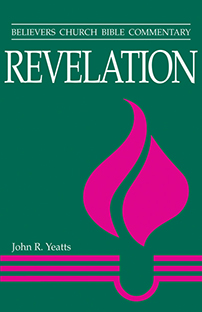Anabaptist Interpretation of Revelation (in Revelation)
![]() Home A B C D E F G H I J K L M N O P Q R S T U V W X Y Z Abbreviations Glossary
Home A B C D E F G H I J K L M N O P Q R S T U V W X Y Z Abbreviations Glossary
Anabaptist eschatology has reflected the beliefs of the evangelical church in general. Yet the uniqueness of the Anabaptist interpretation of Revelation lies in its martyr the- ology (see Correll, 1956:2.247). The great battle between God and the forces of Satan is being fought in this world by martyrs.
Many of the early Anabaptists interpreted the symbols of Revelation literally, applying them to Catholic and Protestant church leadership. In South Germany, Michael Sattler identified the seven heads and ten horns of the beast with the Roman church hierarchy. In Zurich, Anabaptists identified Zwingli with the red dragon of Revelation (Clasen, 1972:119). They believed that the suffering of the sixteenth century was evidence that they were in the last days. Thomas Müntzer predicted that the second coming would occur on Pentecost, 1528 (Klaassen, 1981:316-17), and during the time of the German Peasant’s War in 1526, Hans Hut predicted: “The final and most terrible times of this world are upon us” (quoted in Liechty, 1994:64). Other Anabaptist leaders rejected such speculations. Balthasar Hubmaier said:
- Concerning this I very strongly opposed Hans Hut and his followers when they hoodwinked the simple people by claiming a definite time for the last day, namely next Pentecost. They convinced them to sell their property and leave wife and child, house and field behind, and are now without means of support. Thus the poor people were convinced to follow him by a seductive error which arose out of ignorance of Scripture. (Quoted in Klaassen, 1981:324)
During the sixteenth century, Anabaptist thinking separated into violent and quiet eschatology (Littell, 1958:102-3). Following Joachim of Fiore, Melchior Hoffman divided history into three parts and predicted that the end would come in 1536. He taught that in 1533 the godless of Strasbourg would be massacred and the 144,000 followers of Hoffman would go out to witness Christ’s return (Clasen, 1972:119). All of this would come about, not by human force, but by divine intervention (Krahn, 1981:100). He affirmed the city of Münster to be the millennial commonwealth; and one of his successors, Jan of Leyden, proclaimed himself to be the Davidic Messiah (Rowland, 1998:540). Bernhard Rothmann called Münster the center of the kingdom and advocated violent overthrow of the enemy: “They will make plowshares and hoes into swords and spears. They shall choose a captain, fly the flag, and blow the trumpet. They will incite an obstinate and merciless people against Babylon” (quoted in Klaassen, 1981:335). By the end of the sixteenth century, only a few made eschatological predictions and violent eschatology faded out.
Most Anabaptists accept what has been called quiet eschatology. Menno Simons and Dirk Philips represent this approach to Revelation. Menno clearly identified the antichrist with the Roman church (Klaassen, 1981:342). Yet he saw the kingdom of God as spiritual (Keeney, 1968:180). He believed, on the basis of scripture rather than world events, that Christ would come from outside history to judge the world and that resurrection is personal like the resurrection of Jesus (185, 186). This view was quite prevalent in Anabaptist circles for two centuries.
However, there were persons that, although not violent, expected a literal millennial reign of Christ on this earth. For example, in the 1890s Claas Epp Jr., a Russian Mennonite farmer and preacher, believed that the tribulation was imminent and would be particularly threatening to Mennonites’ pacifistic exemption from the military. Epp led six hundred Mennonites from the Volga River area of Southern Russia hoping to find refuge in Turkestan and to meet the Lord there in 1889. Disappointed in that expectation, some found their way to North America (Belk, 1976). In the late nineteenth century, churches in the Anabaptist tradition rejected even more the literalist approach to Revelation. Perhaps through accommodation with the ideas of the mainline church, the second coming, resurrection, and judgment were given more symbolic interpretations. Nevertheless, the tragedies of the twentieth century (e.g., world wars, economic depression, arms race) led to a revival of evangelical eschatology. Until 1960, premillennialism and dispensationalism received increasing emphasis among Anabaptist-related churches (Correll 1956:2:248). Since then these eschatological views have waned; eschatological hope is more broadly conceived, emphasizing fulfillment now-in-Christ, but consummation yet-to-come.
| —John R. Yeatts |
